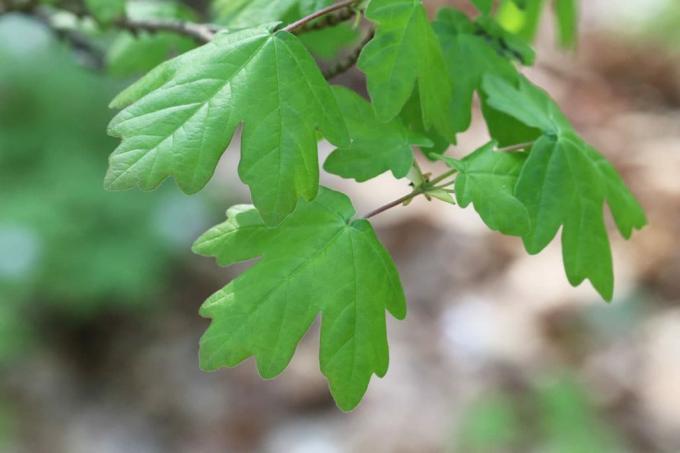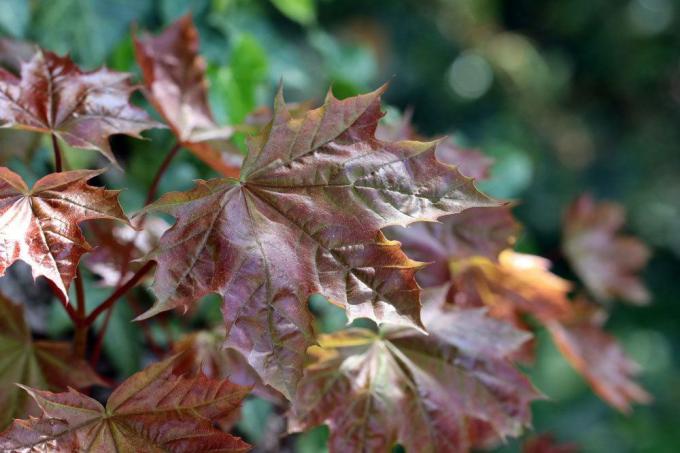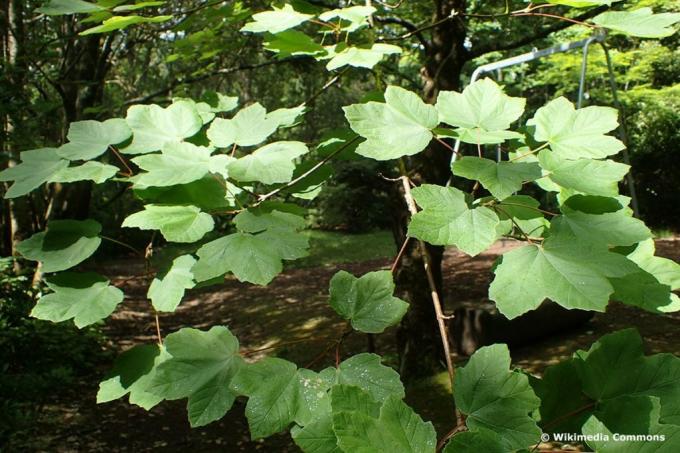
table of contents
- Maple (acer)
- Sycamore maple (Acer pseudoplatanus)
- Field maple (Acer campestre)
- Norway maple (Acer platanoides)
- Regional distribution
- French maple (Acer monspessulanum)
- Snowball maple (Acer opalus)
- frequently asked Questions
Maples are widespread in this country. Because the trees with the typical leaf are often called Ornamental trees planted. But which types of maple are native to Germany?
In a nutshell
- 100 to 200 types of maple
- only three to four of them are indigenous
- easy to distinguish on leaves and fruits
Maple (acer)
Maple species are a separate genus in the soap tree family (Sapindaceae). The plant genus includes 100 to 200 species, many of which can be found in gardens. However, only five types of maple are native to Germany, namely:
- Sycamore maple
- Field maple (Maßholder)
- Norway maple (pointed-leaved maple)
- French maple (rock maple, sycamore maple)
- Snowball maple (spring maple, Italian maple)
Sycamore maple (Acer pseudoplatanus)
Occurrence
- Largest distribution in middle and higher mountain areas (mixed forest together with beech and fir or with spruce)
- Accompanying tree in mixed linden and maple forests, ravine and alluvial forests
- Natural occurrence in Germany: Harz, Ore Mountains, Bavarian Forest, Fichtel Mountains, Allgäu Alps
- Introduced by humans in numerous other regions and subsequently feral
- most common type of maple in Germany

Habitus
The sycamore maple grows as a tree with a height between 20 and 40 meters.
Foliage leaves
- arranged opposite
- Petiole: 3 to 15 centimeters, does not contain milky sap
- Leaf blade: five-lobed (palmate lobes), up to about 20 centimeters long and 10 to 15 centimeters wide, light hairs on the leaf veins
- Leaf lobes: three fully developed (in the front part of the leaf), two not fully developed (in the rear part of the leaf), meet at an acute angle, pointed at the end (shorter than at Norway maple)
- Leaf margin: bluntly serrate
- Upper side of the leaf: dark green
- Underside of leaf: gray-green
- Autumn color: intense golden yellow, bright reddish in higher regions
fruit
- winged nuts
- hang in pairs or in small groups
- up to five inches long and five to six inches wide
- Wings: acute or right angled to each other
- Fruit ripening: late August to early October
Note: With a possible age of up to 500 years, the sycamore maple and field maple survive two to three times as much.
Field maple (Acer campestre)
Occurrence
- Plain to hill country
- in oak-hornbeam forests, beech and alluvial forests
- in the mountains up to a height of 800 meters
- Occurrence in German forests: Bavaria, Mecklenburg-Western Pomerania, Thuringia
- is often planted as an ornamental tree in gardens and parks, as an accompanying greening on roadsides or on windbreaks in plains or as a hedge

Habitus
The field maple grows as a shrub or tree with a height between three and twenty meters.
Foliage leaves
- arranged opposite
- Petiole: five to nine inches long, contains milky sap
- Leaf blade: three to five obtuse-angular lobes, up to about 8 inches long and five to eight inches wide, light hairs on the leaf veins
- Leaf lobes: rounded bays between the lobes, lower leaf lobes usually very small
- Leaf margin: smooth
- Upper side of the leaf: dark green
- Underside of the leaf: lighter than the upper side
- Autumn color: bright golden yellow to chimney red
fruit
- winged nuts
- five to six inches wide
- Wings: almost horizontal to each other
- Fruit ripening: August to September
Norway maple (Acer platanoides)
Occurrence
- in plains and in the hill country
- in the Northern Alps up to about 1,000 meters
- most often in mixed deciduous forests with linden, ash, English oak, sycamore elm; Canyon forests and moat entrances
- in Germany: almost everywhere, with the exception of the extreme northwest
- Use as an avenue tree, in gardens and parks as an ornamental tree, in urban areas for greening

Note: Since the Norway maple is often planted as an ornamental tree, it is very common in Germany.
Habitus
The Norway maple grows as a tree. With a height of between 20 and 30 meters, it is lower than the sycamore maple.
Foliage leaves
- arranged opposite
- Petiole: up to 20 centimeters long, contains milky sap
- Leaf blade: five-lobed (palmate lobes), up to 18 centimeters long and up to 25 centimeters wide (wider than sycamore maple), light hairs on the leaf veins
- Leaf lobes: three fully developed (in the front part of the leaf), two not fully developed (in the rear part of the leaf), long pointed, blunt bays between the lobes
- Leaf margin: entire
- Upper side of the leaf: dark green, shiny
- Underside of leaf: light green
- Autumn colors: yellow, orange, red
fruit
- winged nuts ("nasal pains")
- up to five inches long and five to six inches wide
- Sashes: obtuse angled to horizontal to each other
- Fruit ripening: from September
Note: In contrast to the sycamore and field maple, the yellow flowers of the norway maple are conspicuous because they show before the leaves shoot.
Regional distribution
There are maple species that are not very widespread in Germany or are only widespread regionally. Nevertheless, they are at home in Germany. We introduce them to you.
French maple (Acer monspessulanum)
Occurrence
- Middle Rhine area, wine-growing areas on the Moselle, Nahe and Main
- occasionally in climatically favorable locations in the upper Elbe valley
- naturalized a long time ago (partly overgrown from castle gardens)

Habitus
The rock maple grows as a small tree or large shrub and is between three and ten meters high.
Foliage leaves
- arranged opposite
- reddish petiole: longer than leaf
- Leaf blade: three-lobed, three to six inches long and three to five inches wide
- Leaf margin: smooth
- Upper side of the leaf: dark green
- Autumn color: golden yellow
fruit
- winged nuts ("nasal pains")
- up to five inches long and five to six inches wide
- Wings: V-shaped, parallel to each other
- Fruit ripening: late August to early October
Snowball maple (Acer opalus)
Occurrence
- in Germany only about five copies
- in the German high Rhine area near Grenznach

Habitus
The snowball maple grows as a tree or large shrub with a height of up to 20 meters.
Foliage leaves
- arranged opposite
- Petiole: 10 to 15 centimeters long, contains no milky sap
- Leaf blade: three-lobed, rarely five-lobed, 12 to 14 centimeters wide, light hairs on the main veins on the underside of the leaf
- Leaf margin: roughly serrated
- Upper side of the leaf: dark green
- Underside of leaf: blue-gray-green
- Autumn color: yellow, orange
fruit
- winged nuts ("nasal pains")
- Wings: acute-angled to right-angled to each other
frequently asked Questions
Not all of the 100 or so maple species are poisonous. Among the native species, only the sycamore maple contains toxic substances. However, the symptoms of poisoning only occur in humans when larger amounts are consumed. Touching leaves and seeds is harmless.
The main danger for the sycamore maple is the soot bark fungus, which causes the trees to die. The fungus was first detected in Germany in 2005. The maple was hit particularly hard in 2018/2019, which is attributed to the hot, dry summers.
The field maple grows about 40 to 45 centimeters in height each year. The sycamore maple grows around 80 centimeters per year when it is young. With a height increase of 40 to 60 centimeters, the Norway maple lies in the middle.
